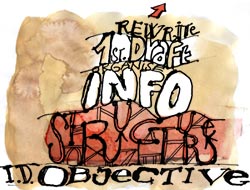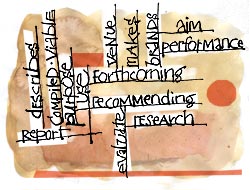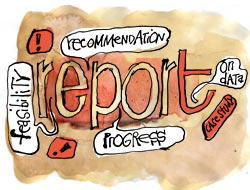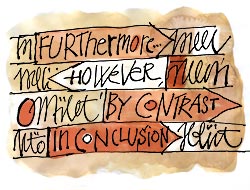4. Writing reports: Introduction and methodology
1. What is a report?

Read the description and report writing tips and choose the correct heading for each section.
3. Report types.

Read the introductions to five different reports described in the previous exercise. Choose the correct report type for each introduction.
4. Useful nouns.

Certain nouns appear with high frequency in the different report types focused on in the previous exercises. Use the nouns to complete the introductions.
5. Report headings.

TIP:
Written reports are usually divided into clearly defined sections, to present information in a clear and logical way. These section headings will also help you to organise information and plan the report you are writing.Put the section headings into a logical order, as you would expect them to appear in a report.
6. Sentence completion.
Put the phrases in order to complete sentences marking key stages in a report.
7. An appropriate introduction.

Read three different versions of the same introduction. Which is the best version?
8. Opening sentences.
Put the phrases in the correct order to complete the sentences from the introduction of a report.
9. Vocabulary.

Practise vocabulary commonly found in report introductions by using the words to complete two introductions.
10. Style: Passive vs. active voice.
TIP:
In exercise 7 of this section we commented on how a formal style is normally more appropriate in the introduction of a written report. One way of achieving a formal style is to use the passive voice.Write in the missing words to complete the second sentence in each pair, so that it has the same meaning as the first sentence.
11. Overall effect.

TIP:
It is important to be aware of characteristics of an effective report. Aim to incorporate these characteristics into your own reports.Read two different versions of the Methodology section of a report. Choose the more effective version.
Version 1
To decide on a venue, primary and secondary research was made. The
conference requirements were
acquired from the CCC
organisation. Rental information was requested. Information was
compared. The official Web site of the local transport authority
was consulted. A site visit and inspection of the two venues were
carried out. Evaluation was made according to the criteria. The
criteria are capacity, cost, transport options, venue facilities,
etc.
Version 2
With the aim of selecting the new conference venue, primary and
secondary research were carried out. First, the conference
requirements were acquired directly from the CCC organisation.
Rental information was then requested from the offices of the
corresponding companies. This information was collated for
comparison. In addition, the official Web site of the local
transport authority was consulted and different transport options
were evaluated. Finally, a site visit and inspection of the two
proposed venues were carried out. Evaluation and recommendations
were then made according to the criteria stated in the
introduction of this report.
12. Linking and sequencing.
Now put the lines in order to complete Version 2 of the methodology section.

